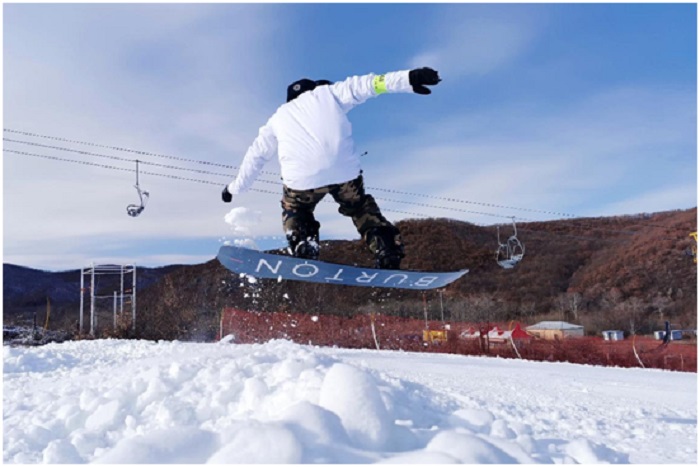



After a trip to a ski resort in Chongli district, north China’s Hebei province, in the winter of 2015, Yang He, a young man born in the 1990s, has become obsessed with skiing and has been to ski resorts every snow season since.
Today, there are more ice and snow sports enthusiasts like Yang in China. Because of preparations for the Beijing 2022 Olympic and Paralympic Winter Games, China’s ice and snow industry has continued to expand, and relevant facilities have been increasingly improved. Ice and snow sports that were once regarded as niche sports have become popular choices for fitness.
At the same time, new business forms in the industry, including ice and snow sport experiencing, training and tourism, have sprouted up, creating a continuously growing market.
Ice and snow sports, which involve gear, training, and practice, require people who participate in them to have certain purchasing power.
Thanks to China’s rapid economic and social development as well as the improvement in the living standards of the Chinese people, demands and consumption of products related to ice and snow sports have kept rising.
Data from China’s e-commerce giant JD.com suggest that during the country’s Singles’ Day shopping festival this year, orders for skiing products supplied directly by the platform increased by 23 times year on year. The transaction volume of ice skating equipment rose 15 times compared with the same period last year.
According to Yang, he has several sets of ski gear at different price levels and uses a special cabinet to keep them, including snowboards, snowsuits, snowshoes, snowboards helmets, goggles, and ski poles.
“At first, I rented ski equipment at ski resorts. Over the past few years, I gradually purchased a whole set and then continuously upgraded my gear,” he said, adding that during this year’s Singles’ Day shopping festival, he spent nearly 10,000 yuan ($1,565) on a snowboard.
Another key driver of ice and snow consumption is ice and snow tourism—spending vocations at ski resorts nearby with family and friends is a new fashion trend in China.
A report on China’s ice and snow tourism development released in January shows that 55 percent of the consumers surveyed are willing to take long-distance trips for ice and snow tourism, and 82 percent would like to take short-distance ones to ice and snow tourist attractions.
The growing popularity of ice and snow tourism has also driven the development of relevant supporting industries and services, such as catering and accommodation, injecting vitality into the economic development of many regions across the country.
“After skiing, I usually go to a hot spring, enjoy local food, and visit specialty stores,” said Yao Jiamei, a citizen in Beijing who has been to more than 10 ski resorts during the past six years since she fell in love with the sport.
Yao believes that the ice and snow boom in China is fundamentally a result of people’s income growth and their increasing interest in the sport.
During the snow season from the end of 2018 to the beginning of 2019, China’s ice and snow tourists totaled 224 million. Their per capita expenditure on a single trip to ice and snow destinations reached about 5,000 yuan, according to a report on the country’s ice and snow tourism consumption.
As indicated by these figures, the ever-expanding ice and snow consumption signals golden opportunities for the development of China’s ice and snow sector.
Operators of ice rinks and ski resorts understand the opportunities generated by the ice and snow boom the best.
At a skating center in Chaoyang district, Beijing, training courses on figure skating and ice hockey are arranged from morning to night every day. “When we opened in 2017, we only had one ice hockey team. Now we have eight,” said Yang Yiwei, general manager of the skating center.
“Hitching a ride in the 2022 Olympic and Paralympic Winter Games, we have constantly improved the facilities at our ski resort and reaped the fruits of the growing number of skiers,” said Hu Wei, general manager of the Nanshan Ski Resort in Beijing, adding that the ski resort received over 400,000 skiers during the last snow season.
Statistics from the General Administration of Sports of China suggest that as of the beginning of 2021, there were 654 standard ice rinks and 803 indoor and outdoor ski resorts across China, an increase of 317 percent and 41 percent, respectively, from 2015.
Since Beijing won the bid for hosting the 2022 Olympic and Paralympic Winter Games in 2015, ice and snow sports have been gradually popularized across the country and made available throughout the year, and the ice and snow industry is playing an increasingly important role in the country’s economy.
From 2015 to 2020, the scale of China’s ice and snow industry grew from 270 billion yuan to 600 billion yuan, says a report on the development of the industry in China. The output value of China’s ice and snow sector is expected to exceed one trillion yuan by 2025, according to the country’s winter sports development plan (2016-2025).


The Executive and members of the.


The Acting Director, FCT Directorate of.


President Bola Ahmed Tinubu has been.



Barely a month after resignation of.


An Abuja based Legal Practitioner, Osuagwu.



Convener of Equitable Remedy, Mrs. Magaret.


Contractors handling the contract for city.


Nigerian government may have concluded plans.


The Diplomatic Correspondents Association of Nigeria.


A rights group, “Follow Me Talk.
Leave a Comment